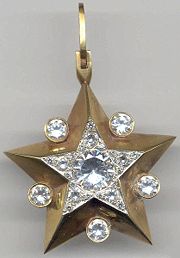
Marshal's Star
Encyclopedia

The marshal's star corresponds with the western use of the marshal's baton
Baton (symbol)
The ceremonial baton is a short, thick stick, carried by select high-ranking military officers as a uniform article. The baton is distinguished from the swagger stick in being thicker and less functional . Unlike a staff of office, a baton is not rested on the ground...
. On the death of the recipient, the award is returned to the diamond fund for re-use.
Recipients
The official name, size and number of diamonds correspond to the marshal's rank. Marshal's stars were first awarded to the marshals of the Soviet UnionMarshal of the Soviet Union
Marshal of the Soviet Union was the de facto highest military rank of the Soviet Union. ....
and admirals of the fleet of the Soviet Union
Admiral of the Fleet of the Soviet Union
An Admiral of the Fleet of the Soviet Union was the highest naval rank of the Soviet Union.The rank was largely honorary and could be considered equivalent to Admiral of the Navy in other nations...
. In time, smaller stars were awarded to "marshals of an arm of service" and "chief marshals of an arm of service", admirals of the fleet
Admiral of the Fleet (USSR)
The rank of Admiral of the Fleet was the highest naval rank of the Soviet Union from 1940 to 1955 and second-highest from 1962.The rank has a rather confusing history...
and later generals of the army of the Soviet armed forces.
Large marshal's star
The large medallion is distinct for the ranks of marshal of the Soviet Union (instituted 2 September 1940) and admiral of the fleet of the Soviet Union (from 3 March 1955). In the Russian Federation there is only one title, marshal of the Russian Federation.It is a gold five-pointed star with smooth diaganol rays on the front side. In the center is a platinum, five-pointed star with diamonds. The diamonds in the center have a total weight of 2.62 carats and in the rays there are 25 diamonds weighing a total of 1.25 carats. Between the edges of rays are 5 diamonds weighing a total of 3.06 carats. The diameter of the gold star is 44.5 millimetres (1.8 in) and the platinum stars are 23 millimetre (0.905511811023622 in) in diameter. The star has a depth of 8 millimetre (0.31496062992126 in).
The marshal's star has a triangular eyelet in the upper beam which is connected to an oval eyelet measuring 14 millimetre (0.551181102362205 in). The marshal's star is suspended by a 25 millimetre (0.984251968503937 in) moire
Moire (fabric)
In textiles, a moire is a fabric with a wavy appearance produced mainly from silk, but also wool, cotton and rayon. The watered appearance is usually created by the finishing technique called calendering...
ribbon. The total weight of the large marshal's star is 36.8 grams (1.3 oz). Approximately 200 of this type of marshal's star were produced.
After the dissolution of the Soviet Union in the early 1990s, the ranks of marshal and chief marshal were abolished, and the marshal of the Russian Federation remains the sole rank entitled to such a decoration. Retired marshals, chief marshals, army generals, and fleet admirals, however, were allowed to retain their former ranks and their corresponding stars.
There are presently no holders of the rank of marshal of the Russian Federation in the modern Russian armed forces.
Small marshal's star
The small star was awarded to marshals of artillery, air marshals and marshals of armoured forces (from 27 February 1943), marshals of the corps of engineers and signal corps (from 20 March 1944), admirals of the fleet (from 5 June 1962), and army generals (from 1 November 1974). Awards continued in the modern Russian Army until 21 January 1997 for army generals and admirals of the fleet.The decoration is a five-pointed gold star with smooth dihedral rays on the obverse. On top of the gold star there is a smaller five-pointed star made of platinum. In the center of the platinum star there is a 2.04-carat diamond. In the rays of platinum star there are twenty five 0.91-carat diamonds. The total diameter of the gold star is 42 millimetres (1.7 in) and it weighs 35.1 grams (1.2 oz). It is connected to a moire ribbon in the same way as the large star. About 370 small marshal's stars have been produced.

